2019 Hyundai Santa Fe wheel
[x] Cancel search: wheelPage 616 of 682
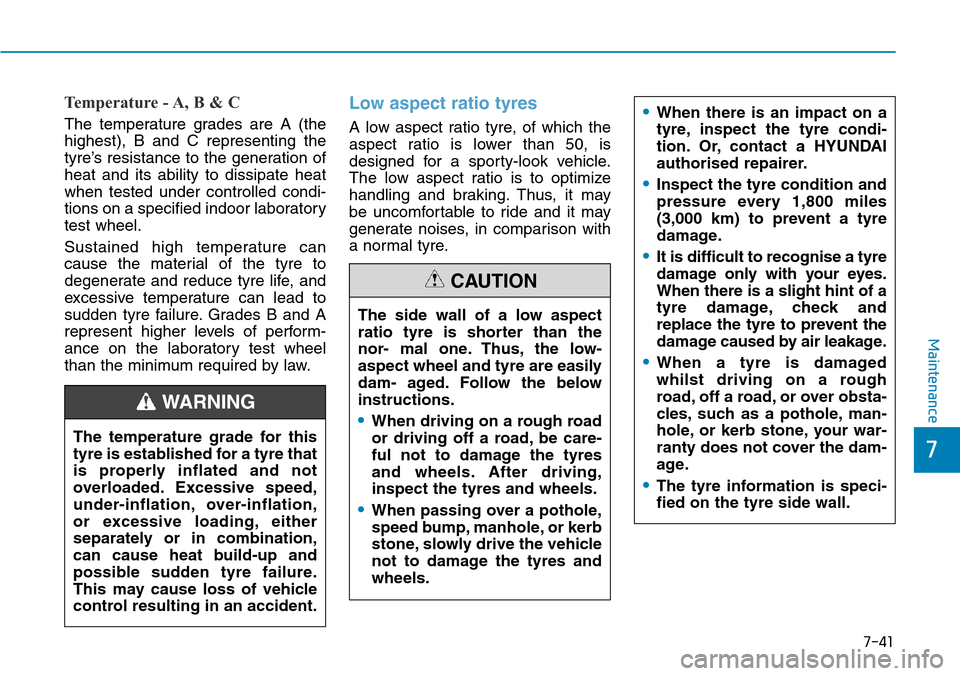
7-41
7
Maintenance
Temperature - A, B & C
The temperature grades are A (the
highest), B and C representing the
tyre’s resistance to the generation of
heat and its ability to dissipate heat
when tested under controlled condi-
tions on a specified indoor laboratory
test wheel.
Sustained high temperature can
cause the material of the tyre to
degenerate and reduce tyre life, and
excessive temperature can lead to
sudden tyre failure. Grades B and A
represent higher levels of perform-
ance on the laboratory test wheel
than the minimum required by law.
Low aspect ratio tyres
A low aspect ratio tyre, of which the
aspect ratio is lower than 50, is
designed for a sporty-look vehicle.
The low aspect ratio is to optimize
handling and braking. Thus, it may
be uncomfortable to ride and it may
generate noises, in comparison with
a normal tyre.•When there is an impact on a
tyre, inspect the tyre condi-
tion. Or, contact a HYUNDAI
authorised repairer.
•Inspect the tyre condition and
pressure every 1,800 miles
(3,000 km) to prevent a tyre
damage.
•It is difficult to recognise a tyre
damage only with your eyes.
When there is a slight hint of a
tyre damage, check and
replace the tyre to prevent the
damage caused by air leakage.
•When a tyre is damaged
whilst driving on a rough
road, off a road, or over obsta-
cles, such as a pothole, man-
hole, or kerb stone, your war-
ranty does not cover the dam-
age.
•The tyre information is speci-
fied on the tyre side wall.
The temperature grade for this
tyre is established for a tyre that
is properly inflated and not
overloaded. Excessive speed,
under-inflation, over-inflation,
or excessive loading, either
separately or in combination,
can cause heat build-up and
possible sudden tyre failure.
This may cause loss of vehicle
control resulting in an accident.
WARNING
The side wall of a low aspect
ratio tyre is shorter than the
nor- mal one. Thus, the low-
aspect wheel and tyre are easily
dam- aged. Follow the below
instructions.
•When driving on a rough road
or driving off a road, be care-
ful not to damage the tyres
and wheels. After driving,
inspect the tyres and wheels.
•When passing over a pothole,
speed bump, manhole, or kerb
stone, slowly drive the vehicle
not to damage the tyres and
wheels.
CAUTION
Page 637 of 682
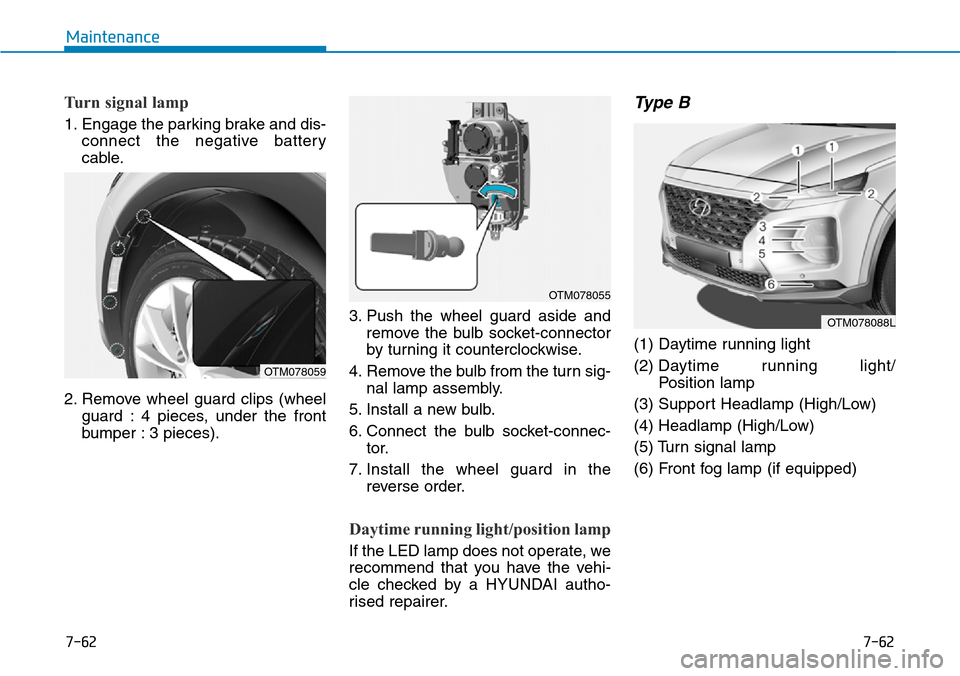
7-62
Maintenance
7-62
Turn signal lamp
1. Engage the parking brake and dis-
connect the negative battery
cable.
2. Remove wheel guard clips (wheel
guard : 4 pieces, under the front
bumper : 3 pieces).3. Push the wheel guard aside and
remove the bulb socket-connector
by turning it counterclockwise.
4. Remove the bulb from the turn sig-
nal lamp assembly.
5. Install a new bulb.
6. Connect the bulb socket-connec-
tor.
7. Install the wheel guard in the
reverse order.
Daytime running light/position lamp
If the LED lamp does not operate, we
recommend that you have the vehi-
cle checked by a HYUNDAI autho-
rised repairer.
Type B
(1) Daytime running light
(2) Daytime running light/
Position lamp
(3) Support Headlamp (High/Low)
(4) Headlamp (High/Low)
(5) Turn signal lamp
(6) Front fog lamp (if equipped)
OTM078088L
OTM078059
OTM078055
Page 651 of 682
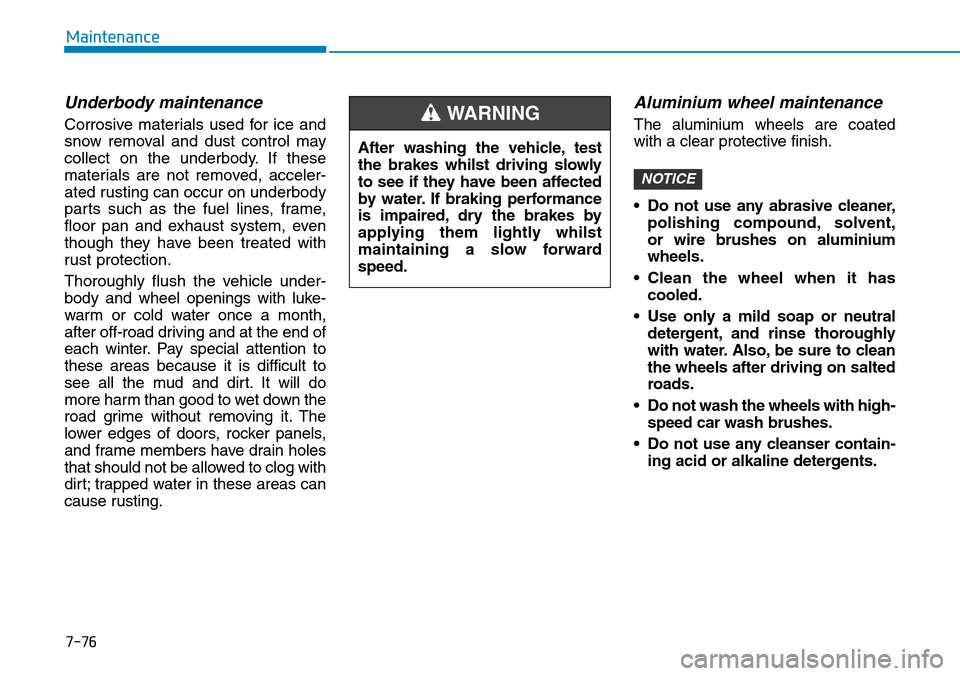
7-76
Maintenance
Underbody maintenance
Corrosive materials used for ice and
snow removal and dust control may
collect on the underbody. If these
materials are not removed, acceler-
ated rusting can occur on underbody
parts such as the fuel lines, frame,
floor pan and exhaust system, even
though they have been treated with
rust protection.
Thoroughly flush the vehicle under-
body and wheel openings with luke-
warm or cold water once a month,
after off-road driving and at the end of
each winter. Pay special attention to
these areas because it is difficult to
see all the mud and dirt. It will do
more harm than good to wet down the
road grime without removing it. The
lower edges of doors, rocker panels,
and frame members have drain holes
that should not be allowed to clog with
dirt; trapped water in these areas can
cause rusting.
Aluminium wheel maintenance
The aluminium wheels are coated
with a clear protective finish.
• Do not use any abrasive cleaner,
polishing compound, solvent,
or wire brushes on aluminium
wheels.
• Clean the wheel when it has
cooled.
• Use only a mild soap or neutral
detergent, and rinse thoroughly
with water. Also, be sure to clean
the wheels after driving on salted
roads.
• Do not wash the wheels with high-
speed car wash brushes.
• Do not use any cleanser contain-
ing acid or alkaline detergents.
NOTICE
After washing the vehicle, test
the brakes whilst driving slowly
to see if they have been affected
by water. If braking performance
is impaired, dry the brakes by
applying them lightly whilst
maintaining a slow forward
speed.
WARNING
Page 653 of 682
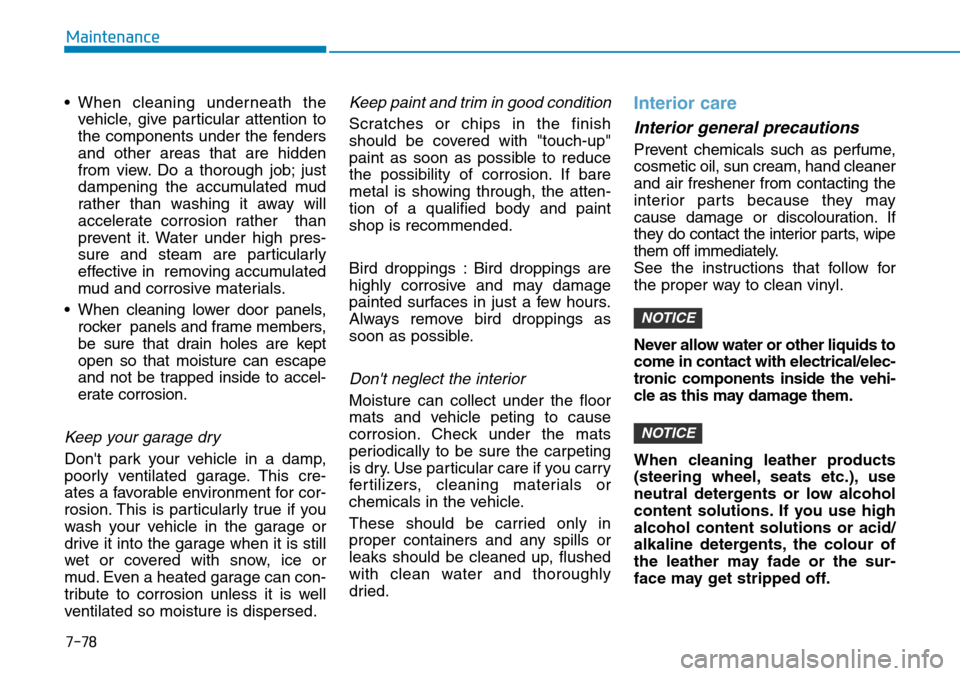
7-78
Maintenance
• When cleaning underneath the
vehicle, give particular attention to
the components under the fenders
and other areas that are hidden
from view. Do a thorough job; just
dampening the accumulated mud
rather than washing it away will
accelerate corrosion rather than
prevent it. Water under high pres-
sure and steam are particularly
effective in removing accumulated
mud and corrosive materials.
• When cleaning lower door panels,
rocker panels and frame members,
be sure that drain holes are kept
open so that moisture can escape
and not be trapped inside to accel-
erate corrosion.
Keep your garage dry
Don't park your vehicle in a damp,
poorly ventilated garage. This cre-
ates a favorable environment for cor-
rosion. This is particularly true if you
wash your vehicle in the garage or
drive it into the garage when it is still
wet or covered with snow, ice or
mud. Even a heated garage can con-
tribute to corrosion unless it is well
ventilated so moisture is dispersed.
Keep paint and trim in good condition
Scratches or chips in the finish
should be covered with "touch-up"
paint as soon as possible to reduce
the possibility of corrosion. If bare
metal is showing through, the atten-
tion of a qualified body and paint
shop is recommended.
Bird droppings : Bird droppings are
highly corrosive and may damage
painted surfaces in just a few hours.
Always remove bird droppings as
soon as possible.
Don't neglect the interior
Moisture can collect under the floor
mats and vehicle peting to cause
corrosion. Check under the mats
periodically to be sure the carpeting
is dry. Use particular care if you carry
fertilizers, cleaning materials or
chemicals in the vehicle.
These should be carried only in
proper containers and any spills or
leaks should be cleaned up, flushed
with clean water and thoroughly
dried.
Interior care
Interior general precautions
Prevent chemicals such as perfume,
cosmetic oil, sun cream, hand cleaner
and air freshener from contacting the
interior parts because they may
cause damage or discolouration. If
they do contact the interior parts, wipe
them off immediately.
See the instructions that follow for
the proper way to clean vinyl.
Never allow water or other liquids to
come in contact with electrical/elec-
tronic components inside the vehi-
cle as this may damage them.
When cleaning leather products
(steering wheel, seats etc.), use
neutral detergents or low alcohol
content solutions. If you use high
alcohol content solutions or acid/
alkaline detergents, the colour of
the leather may fade or the sur-
face may get stripped off.
NOTICE
NOTICE
Page 670 of 682
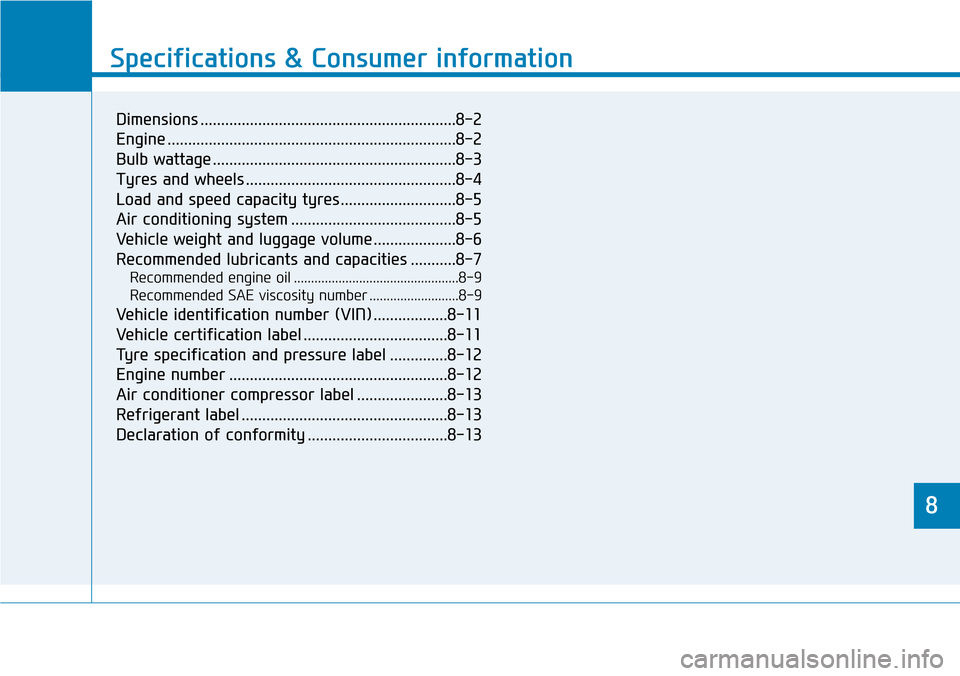
8
Specifications & Consumer information
8
Specifications & Consumer information
8
Dimensions ..............................................................8-2
Engine ......................................................................8-2
Bulb wattage ...........................................................8-3
Tyres and wheels ...................................................8-4
Load and speed capacity tyres ............................8-5
Air conditioning system ........................................8-5
Vehicle weight and luggage volume ....................8-6
Recommended lubricants and capacities ...........8-7
Recommended engine oil ................................................8-9
Recommended SAE viscosity number ..........................8-9
Vehicle identification number (VIN) ..................8-11
Vehicle certification label ...................................8-11
Tyre specification and pressure label ..............8-12
Engine number .....................................................8-12
Air conditioner compressor label ......................8-13
Refrigerant label ..................................................8-13
Declaration of conformity ..................................8-13
Page 671 of 682
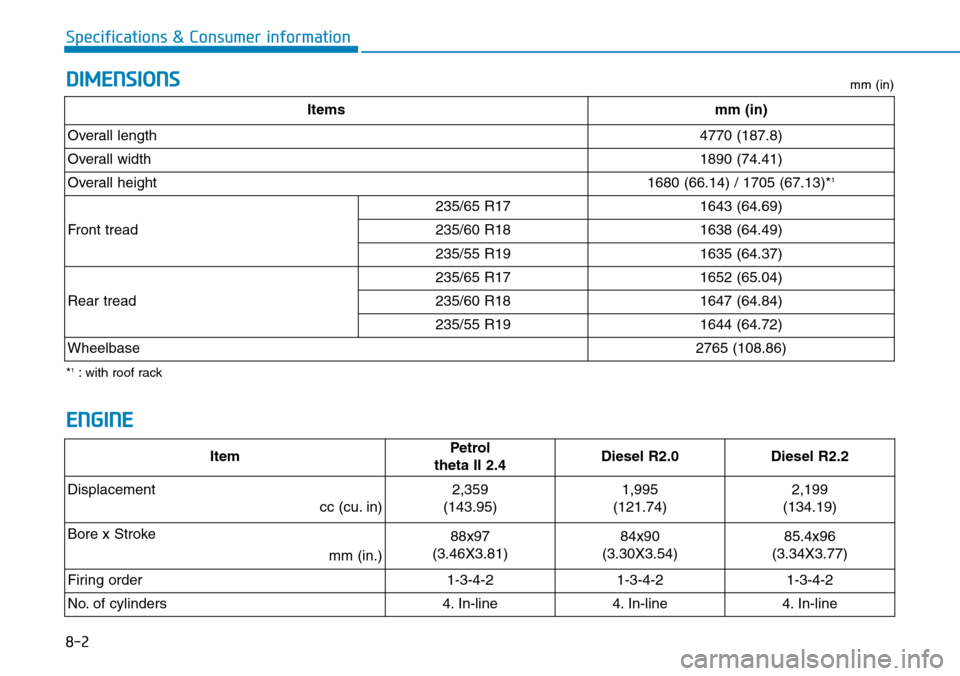
8-2
Specifications & Consumer information
DIMENSIONS
ENGINE
*1: with roof rackmm (in)
Itemsmm (in)
Overall length4770 (187.8)
Overall width1890 (74.41)
Overall height1680 (66.14) / 1705 (67.13)*1
Front tread
235/65 R171643 (64.69)
235/60 R181638 (64.49)
235/55 R191635 (64.37)
Rear tread
235/65 R171652 (65.04)
235/60 R181647 (64.84)
235/55 R191644 (64.72)
Wheelbase2765 (108.86)
ItemPetrol
theta II 2.4Diesel R2.0Diesel R2.2
Displacement
cc (cu. in)
2,359
(143.95)1,995
(121.74)2,199
(134.19)
Bore x Stroke
mm (in.)
88x97
(3.46X3.81)84x90
(3.30X3.54)85.4x96
(3.34X3.77)
Firing order
1-3-4-21-3-4-21-3-4-2
No. of cylinders
4. In-line4. In-line4. In-line
Page 673 of 682

8-4
Specifications & Consumer information
TYRES AND WHEELS
When replacing tyres, use the same size originally supplied with the vehicle.
Using tyres of a different size can damage the related parts or make it work irregularly.
CAUTION
• It is permissible to add 20 kPa (3 psi) to the standard tyre pressure specification if colder temperatures are
expected soon. Tyres typically lose 7 kPa (1 psi) for every 7°C (12°F) temperature drop. If extreme tempera-
ture variations are expected, recheck your tyre pressure as necessary to keep them properly inflated.
• An air pressure generally decreases, as you drive up to a high-altitude area above sea level. Thus, if you plan
to drive a high-altitude area, check the tyre pressures in advance. If necessary, inflate them to a proper level
(Air inflation per altitude: +10 kPa/1 km (+2.4 psi/1 mile)).
• Must do not exceed maximum inflation pressure shown on equipped tyre sidewall.
NOTICE
ItemTyre SizeWheel Size
Inflation Pressure Bar (kPa, psi)Wheel Lug Nut
Torque kgf.m
(lbf.ft, N.m)
Normal loadMaximum load
FrontRearFrontRear
Full size tyre
235/65 R177.0J x 17
2.4 (240,35)2.4 (240,35)11~13
(79~94,107~127)235/60 R187.5J x 18
235/55 R198.0J x 19
Compact spare tyreT165/90 R174.0T x 174.2 (420, 60)T155/85 R184.0T x 18
Page 674 of 682
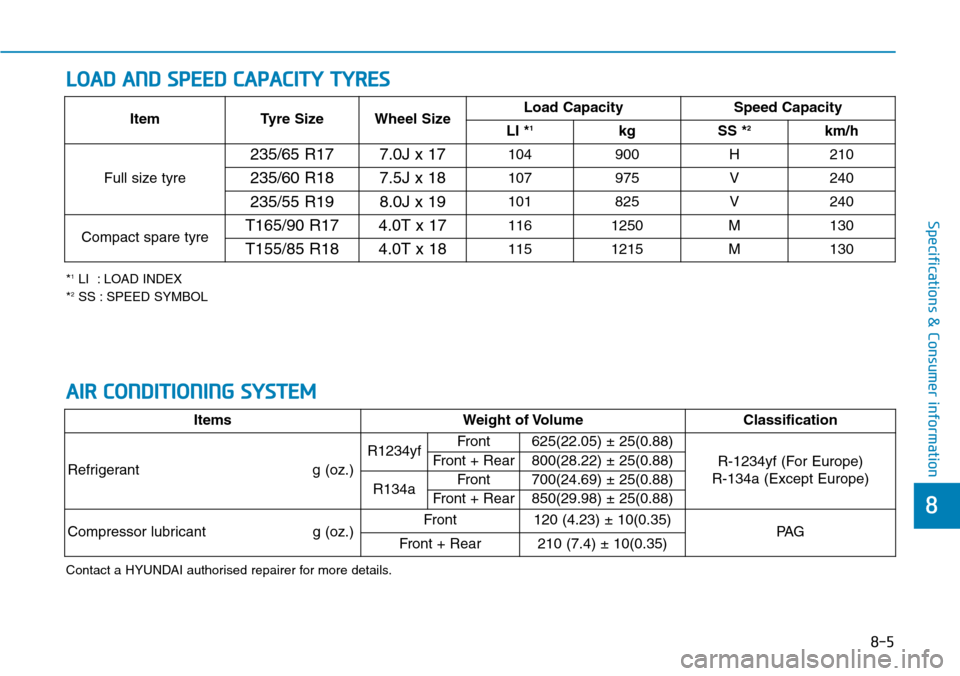
8-5
8
Specifications & Consumer information
*1LI : LOAD INDEX
*2SS : SPEED SYMBOL
LOAD AND SPEED CAPACITY TYRES
AIR CONDITIONING SYSTEM
ItemsWeight of Volume Classification
Refrigerant g (oz.)
R1234yfFront625(22.05) ± 25(0.88)
R-1234yf (For Europe)
R-134a (Except Europe) Front + Rear800(28.22) ± 25(0.88)
R134aFront700(24.69) ± 25(0.88)
Front + Rear850(29.98) ± 25(0.88)
Compressor lubricant g (oz.)Front120 (4.23) ± 10(0.35)PA GFront + Rear210 (7.4) ± 10(0.35)
Contact a HYUNDAI authorised repairer for more details.
Item Tyre Size Wheel SizeLoad Capacity Speed Capacity
LI *1kg SS *2km/h
Full size tyre
235/65 R17 7.0J x 17104 900 H 210
235/60 R18 7.5J x 18107 975 V 240
235/55 R198.0J x 19101825V240
Compact spare tyreT165/90 R174.0T x 171161250M130
T155/85 R184.0T x 181151215M130